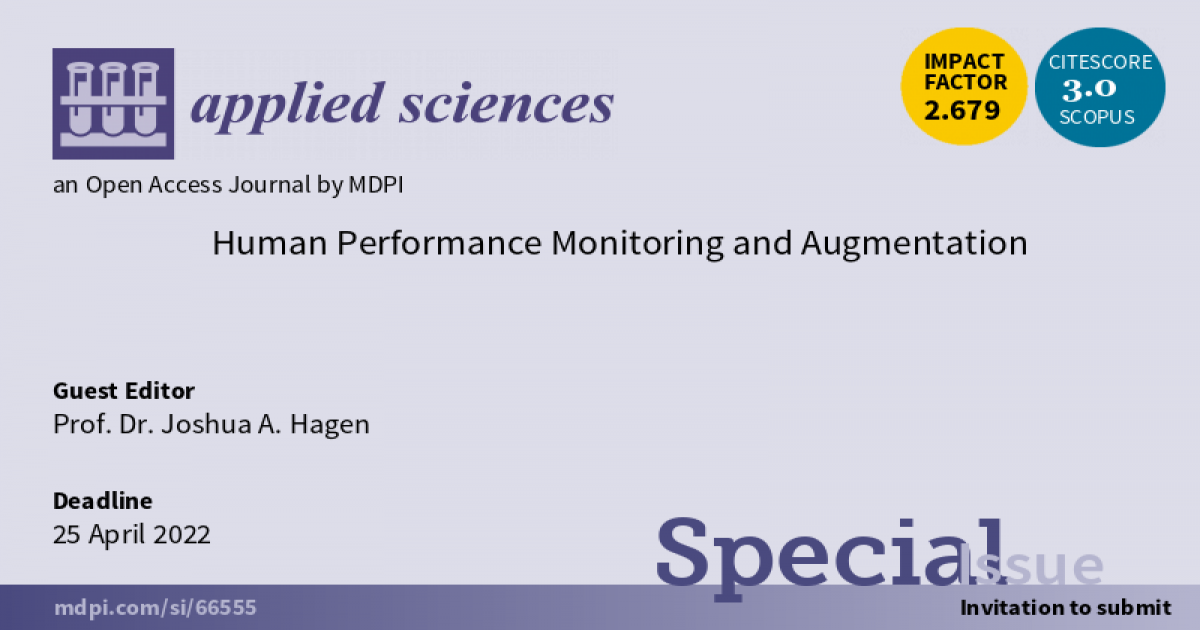- 2.5Impact Factor
- 5.5CiteScore
- 20 daysTime to First Decision
Human Performance Monitoring and Augmentation
This special issue belongs to the section “Applied Biosciences and Bioengineering“.
Special Issue Information
Dear Colleagues,
The field of human performance science has been expanding at a rapid pace over the last decade thanks to technological advances in physiological monitoring devices, data capture technologies, data analytics tools, and performance augmentation modalities, to name a few. These developments have enabled a deeper and more quantified look into the link between physiology and human performance in all populations, ranging from high-performing athletes to generally healthy individuals to the clinically compromised. Importantly, performance is defined based on the population being studied, and (as an example) can take the form of competition results for athletes, general health and wellbeing for healthy individuals, and improved function in clinical patients.
In this Special Issue, we aim to present research that highlights topics along the sense–assess–augment paradigm of human performance. Sense is the science and application of measuring signals in, on, and around the human body. Assess is the analysis and understanding of those signals not just physiologically, but within the context in which it is being analyzed. Finally, augment is the use of techniques and tools to modulate performance. Tying all parts together, you can measure the physiological signals of your population, understand the data, demands, and needs for performance in both the short and long term, and apply methodologies and modalities to positively enhance that performance. Preference will be given to original research that utilizes all domains of the sense–assess–augment paradigm, and all populations of study under this paradigm are welcome.
Prof. Dr. Joshua A. Hagen
Guest Editor
Manuscript Submission Information
Manuscripts should be submitted online at www.mdpi.com by registering and logging in to this website. Once you are registered, click here to go to the submission form. Manuscripts can be submitted until the deadline. All submissions that pass pre-check are peer-reviewed. Accepted papers will be published continuously in the journal (as soon as accepted) and will be listed together on the special issue website. Research articles, review articles as well as short communications are invited. For planned papers, a title and short abstract (about 250 words) can be sent to the Editorial Office for assessment.
Submitted manuscripts should not have been published previously, nor be under consideration for publication elsewhere (except conference proceedings papers). All manuscripts are thoroughly refereed through a single-blind peer-review process. A guide for authors and other relevant information for submission of manuscripts is available on the Instructions for Authors page. Applied Sciences is an international peer-reviewed open access semimonthly journal published by MDPI.
Please visit the Instructions for Authors page before submitting a manuscript. The Article Processing Charge (APC) for publication in this open access journal is 2400 CHF (Swiss Francs). Submitted papers should be well formatted and use good English. Authors may use MDPI's English editing service prior to publication or during author revisions.
Keywords
- human performance
- sport science
- tactical science
- augmentation
- recovery science
- wearable technology
- physiological monitoring
- neuromodulation
- cognitive enhancement

Benefits of Publishing in a Special Issue
- Ease of navigation: Grouping papers by topic helps scholars navigate broad scope journals more efficiently.
- Greater discoverability: Special Issues support the reach and impact of scientific research. Articles in Special Issues are more discoverable and cited more frequently.
- Expansion of research network: Special Issues facilitate connections among authors, fostering scientific collaborations.
- External promotion: Articles in Special Issues are often promoted through the journal's social media, increasing their visibility.
- e-Book format: Special Issues with more than 10 articles can be published as dedicated e-books, ensuring wide and rapid dissemination.

